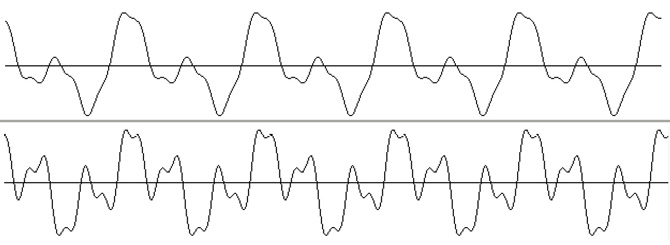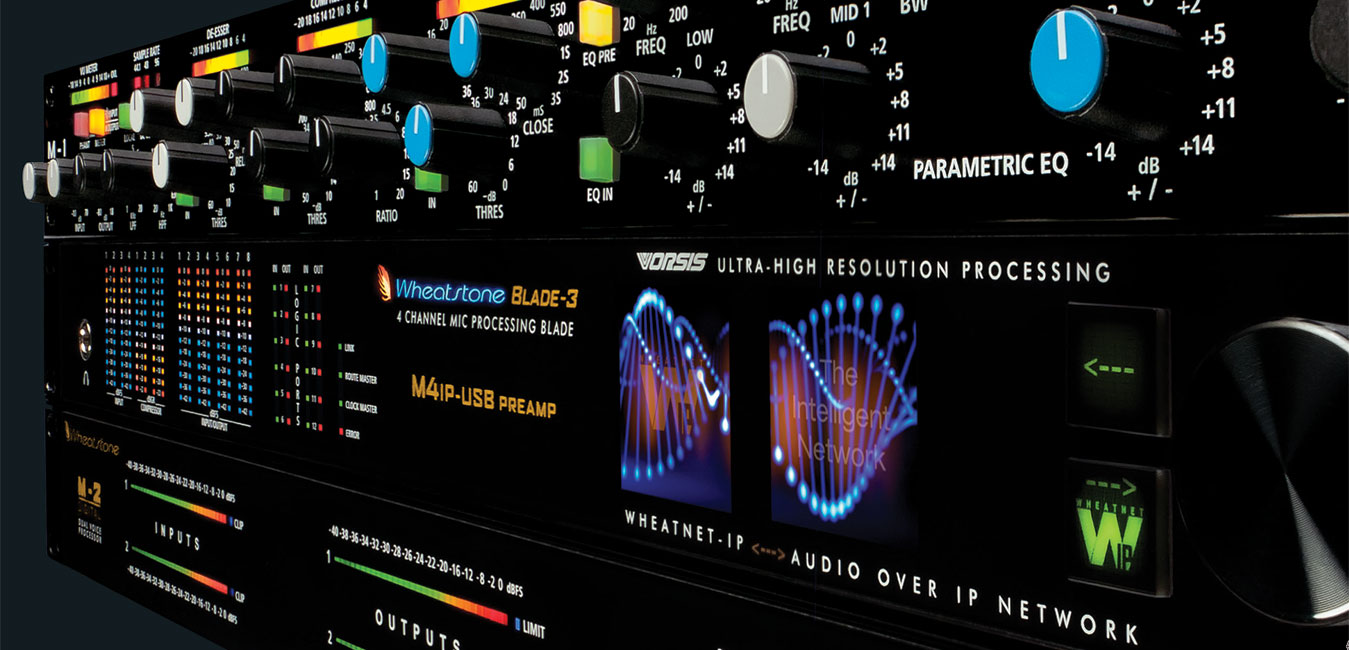
Scott Fybush Interviews Mike Erickson About Mic/Voice Processing
In January, Scott Fybush sat down in Wheatstone's processing lab with Mike Erickson to talk all things processing. These videos deal specifically with mic/voice processing and provide a wealth of insight and information.
Mike Erickson on Mic Processing, Part 1
Mike Erickson on Mic Processing, Part 2
Mike Erickson on Mic Processing, Part 3
Stuff You Should Know About Wheatstone Voice 1, MG-1, M-2 and M4-IP USB Mic Processors
Decent microphone input
With noise figures within 1dB of the theoretical minimum, Wheatstone mic processors have a fairly high input impedance, high available gain and substantial headroom. The gain setting is digitally recallable, and can follow changes in presets. 48V phantom power (for most condenser microphones and a small handful of active ribbon microphones) is selectable.
Plenty of input headroom
As an example, the M4-IP USB has 32dB of input headroom, which is comparable to the best recording consoles — meaning one has to try very hard to break it!
Carefully chosen decorrelator parameters
These allow good performance over all voices, not just males. The 24dB/octave high-pass and low-pass filters (steep!) are constructed using lower 'Q's than is usual, rendering them sonically less disruptive. (Time-smearing has always been an issue with aggressive filters otherwise.)
Top: Pre decorrelator. Bottom: Post Decorrelator

No false-triggered gating
The M4-IP USB gate's sidechain is filtered to voice frequencies, radically reducing false triggering with those attendant annoying bursts of noise. In particular, table and microphone 'bumps' won't wake up the gate. Fine control over attenuation depth, threshold and closing time affords transparent operation.
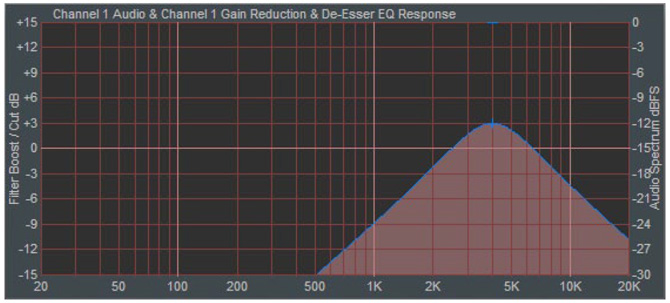
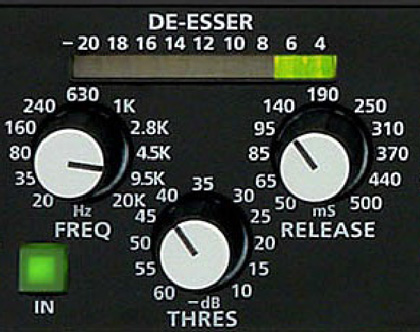
Subtle and selective de-essing.
Rather than just a button, there is full control over the de-esser's threshold (where it decides how much 'ess' is enough), the center frequency, and recovery time. Not so obvious is that the M1/M4-IP USB's de-esser attenuates only the frequency range sensed, unlike the wholesale broadband attenuation of many other units. This makes its action much less obvious.
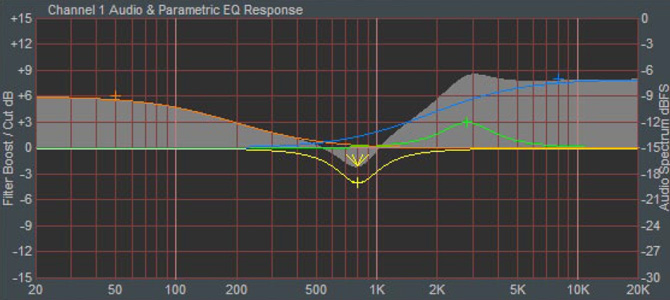
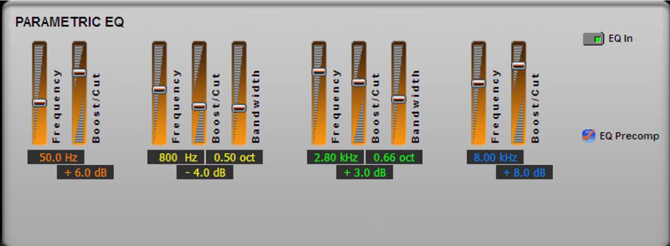
Equalization, a mixture of old and new.
The shelving sections are a mathematically exact emulation of a classic (1950s) Baxandall tone-control circuit, but with modern twists. The turnover frequencies are continuously variable, allowing fine-tuning of proximity-effect reduction at the low frequency end, and choice of 'air' EQ (extreme high frequencies) or far more aggressive 'presence' EQ (high mids) — or anything in between. This is a highly versatile combination. Two fully parametric sections permit more surgical sonic control; although operationally identical to others, these circuits are more complex than standard 'cookbook' parametric sections, with the intention of offering EQ that does what one would expect equalization to do, rather than baldly perform as normal. The key to the equalizer overall is that through carefully chosen defaults, 'shapes', and sonic characteristics, things just fall to hand nicely to accomplish what the operator wants with minimum effort, rather than making him fight for it.
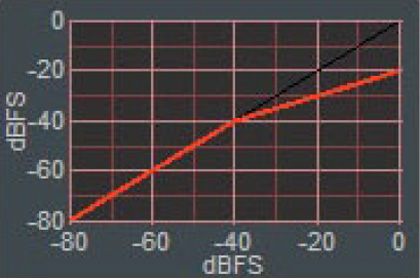
Compression, another blend of classic and modern.
The M1/M4-IP USB compressor design started out as a challenge to make 'the most analog-sounding digital compressor possible'. This it does, if not by direct emulation of classics, then certainly with serious nods to their salient characteristics — but with modern sensibilities applied. Signal sensing that algorithmically blends between peak- and power-sensing detectors, a very graceful soft-knee characteristic, and compound program dependent multiple release rates assure a smooth-sounding sonic result. Underlying the compressor itself is a slow-rate AGC, which allows the section to perform both level correction and more rapid compression effects simultaneously and transparently. The sidechain is subtly filtered to avoid 'bass build-up' and other sonic undesirables. The equalizer is switchable to be either before or after the compressor, as each style of operation has its own benefits.
Protection limiter.
The M4-IP USB has an output limiter that can act either as a 'brickwall' look-ahead limiter or, alternatively, as a slightly more relaxed limiter at a slightly lower threshold, free of the added latency that 'look-ahead' brings with it. This limiter is not intended to be used as an effect, but for protection, reassurance, and guidance. Running the compressor output high to achieve levels as close to 0 dBfs as possible has the danger of overload distortion at the output; the peak limiter here trades some of the mic processor's huge system headroom for avoiding that problem. Indeed, using the twitching of the limiter indicator as a sign that “you're there!” is quite valid as a means of establishing operating level architecture.
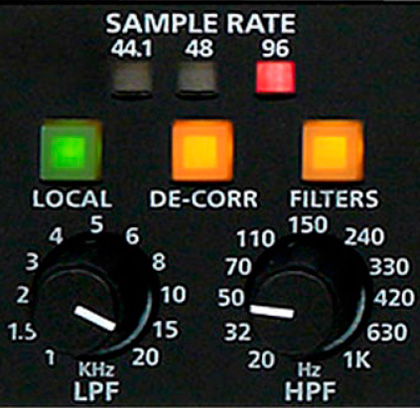
Super-rate processing
2. Improved high-frequency EQ. Not generally appreciated outside the lab is that the top octave (say from 10kHz on up) in a 48kHz system is dominated by the tyranny of inevitable 'zeroes' (notches) at 24kHz, half the sample rate. These zeroes affect the calculation for and accuracy of digital filters in this upper range, taking some questionable heroics to beat them into acceptable sonic shape. Alternatively, running the EQ at 96kHz blows right past the problem (the nettlesome top-octave is now in inaudible-land). Subsequent reduction to 48kHz does not meaningfully affect the now wholly accurate EQ characteristics.
3. Accurate dynamics behavior. Certain spot frequencies (sub-multiples of the sample rate) can suffer serious detection inaccuracies, particularly with peak-sensing detectors found in limiters or fast compressors. In some cases, such as a protection limiter, these can even render the device useless. Running these dynamics at super-rate forces the worst of these 'black holes' an octave up and generally out of harm's way, with any remaining stragglers far easier to contain.
These three results of high-rate processing confer obvious operational benefits and superior sonic performance. An adjective commonly used about the M1 or M4-IP USB's sound is “sweet.” High-rate processing is a large part of the reason.




